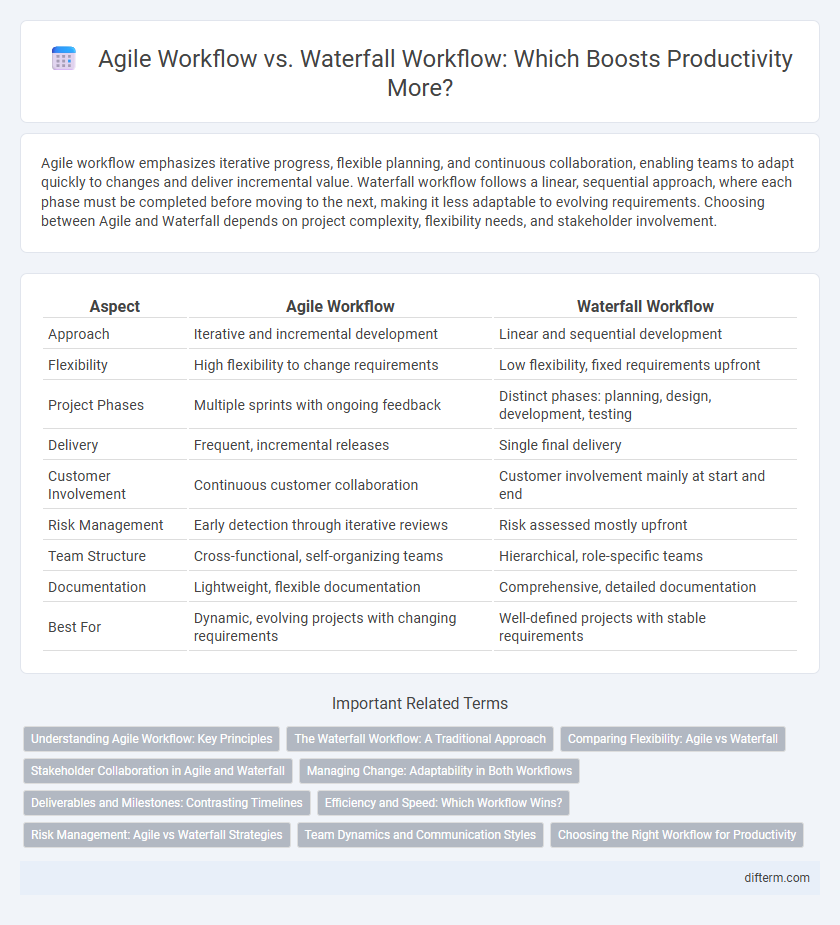Agile workflow emphasizes iterative progress, flexible planning, and continuous collaboration, enabling teams to adapt quickly to changes and deliver incremental value. Waterfall workflow follows a linear, sequential approach, where each phase must be completed before moving to the next, making it less adaptable to evolving requirements. Choosing between Agile and Waterfall depends on project complexity, flexibility needs, and stakeholder involvement.
Table of Comparison
| Aspect | Agile Workflow | Waterfall Workflow |
|---|---|---|
| Approach | Iterative and incremental development | Linear and sequential development |
| Flexibility | High flexibility to change requirements | Low flexibility, fixed requirements upfront |
| Project Phases | Multiple sprints with ongoing feedback | Distinct phases: planning, design, development, testing |
| Delivery | Frequent, incremental releases | Single final delivery |
| Customer Involvement | Continuous customer collaboration | Customer involvement mainly at start and end |
| Risk Management | Early detection through iterative reviews | Risk assessed mostly upfront |
| Team Structure | Cross-functional, self-organizing teams | Hierarchical, role-specific teams |
| Documentation | Lightweight, flexible documentation | Comprehensive, detailed documentation |
| Best For | Dynamic, evolving projects with changing requirements | Well-defined projects with stable requirements |
Understanding Agile Workflow: Key Principles
Agile workflow emphasizes iterative progress, collaboration, and flexibility, enabling teams to adapt quickly to changes and deliver value continuously. Key principles include customer collaboration, working software over comprehensive documentation, and responding to change rather than following a fixed plan. This approach contrasts with the Waterfall workflow's linear, sequential steps, often leading to slower adaptability and delayed feedback integration.
The Waterfall Workflow: A Traditional Approach
The Waterfall workflow is a linear and sequential project management approach where each phase, such as requirements gathering, design, implementation, testing, and deployment, follows a strict order without overlap. It emphasizes thorough documentation and upfront planning, making it ideal for projects with well-defined requirements and minimal expected changes. Despite its predictability and structured nature, the Waterfall model can be less adaptable to evolving project demands compared to Agile methodologies.
Comparing Flexibility: Agile vs Waterfall
Agile workflow offers superior flexibility by allowing iterative progress and continuous feedback integration, enabling teams to adapt quickly to changes in project scope or requirements. Waterfall workflow follows a rigid, linear sequence where each phase must be completed before the next begins, making it less adaptable to modifications once the project is underway. Consequently, Agile is preferable for dynamic projects requiring frequent adjustments, while Waterfall suits projects with well-defined, unchanging objectives.
Stakeholder Collaboration in Agile and Waterfall
Stakeholder collaboration in Agile workflows is characterized by continuous communication, iterative feedback, and active involvement throughout the project lifecycle, enhancing transparency and adaptability. In contrast, Waterfall workflows typically involve stakeholder input primarily at the project's initiation and final delivery stages, limiting opportunities for mid-project adjustments. This fundamental difference significantly impacts project responsiveness and alignment with stakeholder expectations.
Managing Change: Adaptability in Both Workflows
Agile workflow excels in managing change through iterative cycles that allow teams to respond quickly and flexibly to evolving project requirements, enhancing productivity and reducing risk. Waterfall workflow follows a linear, sequential approach that emphasizes thorough upfront planning, making it less adaptable but effective for projects with well-defined, stable requirements. Adapting change in Agile promotes continuous improvement and faster delivery, while Waterfall's rigidity can delay response times to unexpected changes, impacting overall project timelines.
Deliverables and Milestones: Contrasting Timelines
Agile workflow emphasizes iterative deliverables with frequent, incremental milestones enabling rapid adjustments and continuous improvement, promoting flexibility throughout the project timeline. Waterfall workflow follows a linear sequence with fixed milestones and deliverables, creating rigid timelines where each phase must be completed before proceeding to the next. Agile's approach reduces risk by delivering value early and often, whereas Waterfall's structured timeline supports projects with well-defined requirements.
Efficiency and Speed: Which Workflow Wins?
Agile workflow enhances efficiency and speed by promoting iterative development, continuous feedback, and flexible adjustments, enabling faster delivery of usable products. Waterfall workflow follows a linear, sequential process that often delays feedback until project completion, potentially slowing down progress and reducing adaptability. For projects demanding rapid responses and frequent updates, Agile consistently outperforms Waterfall in maximizing productivity and time-to-market.
Risk Management: Agile vs Waterfall Strategies
Agile workflow enhances risk management by promoting iterative development, allowing early detection and mitigation of issues through continuous feedback and adaptive planning. In contrast, Waterfall workflow employs a linear, sequential approach where risk identification and resolution mainly occur at predefined phases, often leading to delayed problem discovery. Agile's flexibility reduces project failure rates by enabling real-time adjustments, while Waterfall's rigid structure can increase vulnerability to unforeseen risks.
Team Dynamics and Communication Styles
Agile workflow fosters adaptive team dynamics through iterative collaboration, frequent feedback loops, and cross-functional communication, enhancing transparency and responsiveness. Waterfall workflow emphasizes structured team roles with sequential communication stages, limiting real-time interactions and slowing response to change. Agile's emphasis on daily stand-ups and collaborative tools promotes continuous alignment, whereas Waterfall relies on formal documentation and milestone-based updates, impacting team cohesion and flexibility.
Choosing the Right Workflow for Productivity
Selecting the optimal workflow between Agile and Waterfall depends on project complexity and flexibility needs, with Agile excelling in iterative development and rapid adaptation to changes, enhancing team productivity through continuous feedback loops. Waterfall offers a linear, structured approach suitable for projects with clearly defined requirements, minimizing scope creep and enabling straightforward progress tracking. Evaluating project goals, stakeholder involvement, and risk tolerance ensures the adoption of a workflow that maximizes productivity and delivers timely results.
Agile workflow vs Waterfall workflow Infographic

 difterm.com
difterm.com